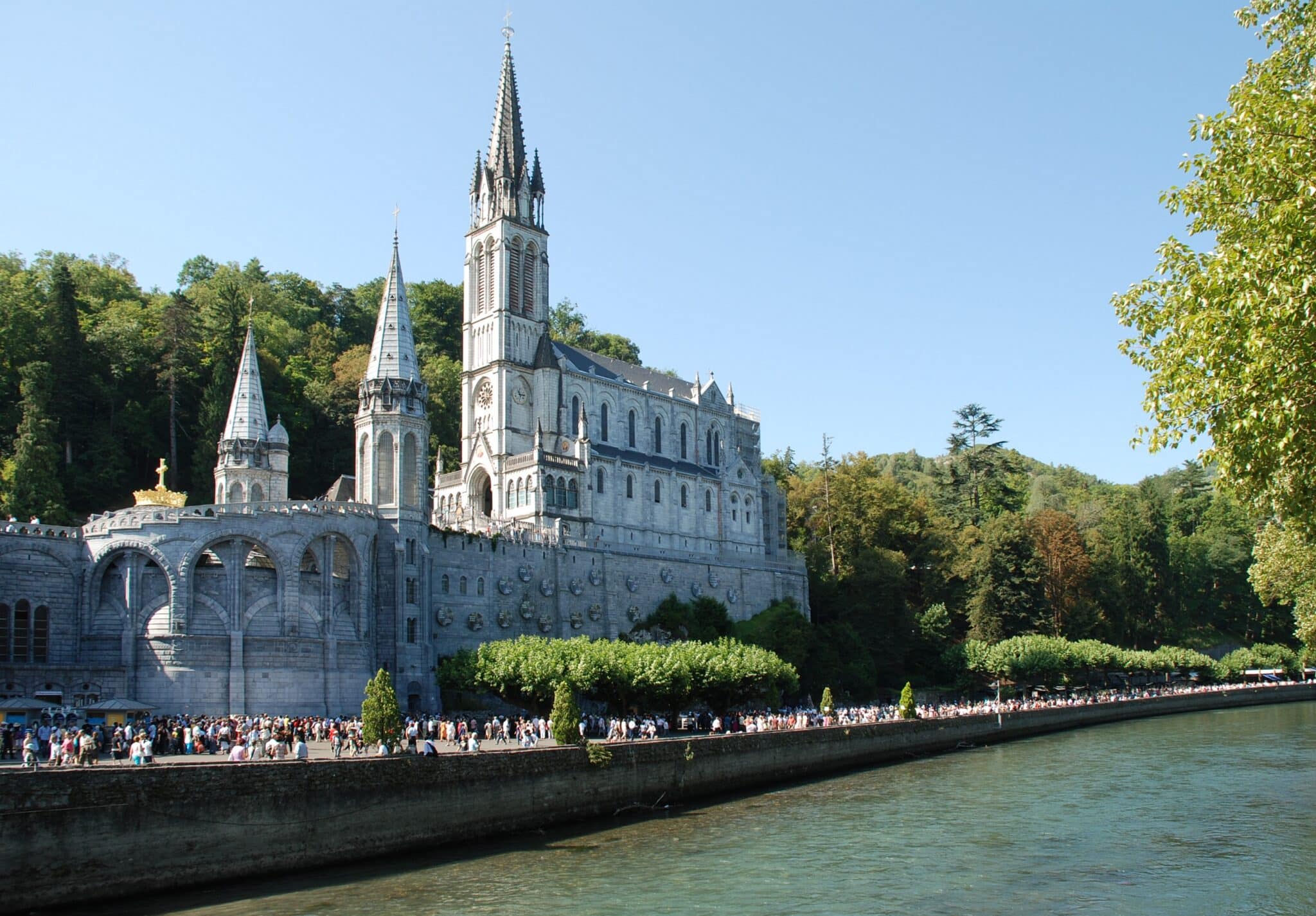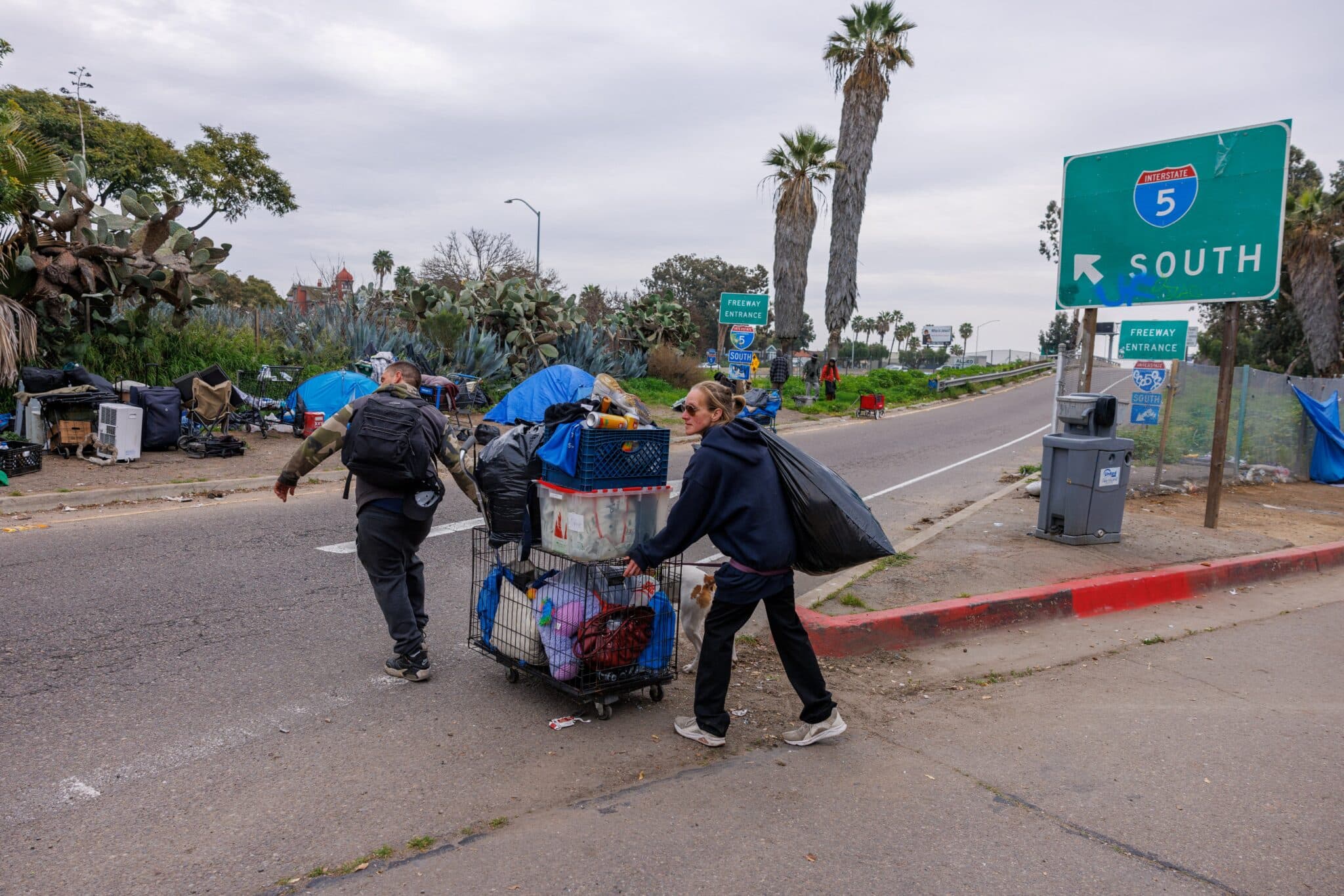The message of Lourdes goes beyond physical healing. Our Lady brings about in us a healing of the heart, where Jesus most wants to touch us all.
At the heart of Lourdes stands an encounter of love between a child and a mother, between Bernadette Soubirous and Mary, Mother of God and our mother. That meeting forever changed the face of a small French village and reawakened the spiritual yearnings of people, making Lourdes a worldwide center of pilgrimage.
In 1858, with a population of little more than 3,000, Lourdes was an obscure village amid the Pyrenees in southwestern France. Among its poorest citizens were members of the Soubirous family. With his wife, Louise, and their four children, Francois Soubirous, a miller by trade, had fallen upon hard times. In 1857 they were forced to live in the Cachot, an abandoned jail.
On Thursday, February 11, 1858, life changed dramatically and decisively for Bernadette. On a cold, damp day, her simple search for firewood initiated an amazing encounter with heaven. Bernadette, her sister Toinette and a friend, Jeanne Abadie, were searching for firewood. At a rocky recess in a place known as Massabielle, where the river currents washed up driftwood and other debris, Bernadette had a vision that left an indelible imprint on her heart and began the story that is Lourdes.
In this grotto she saw a “Lady dressed in white with a blue sash and a yellow rose on each foot, the color of her rosary.” Who the “Lady” was became the subject of much debate. There were 18 apparitions in all, the last one occurring on July 16, 1858.
As news reached the townspeople and neighboring districts, people flocked to the grotto. With the discovery of a spring of water, and the news of healings taking place, the crowds grew.
For Bernadette it was a time of private ecstasy and public hell. She was mocked and ridiculed by some. A 14-year-old illiterate child, she was hounded by police and local authorities, interrogated and even threatened with prison. In the face of this adversity, she remained steadfast. Even the local priest, the Abbé Peyramale, who was skeptical at first, eventually believed her.
He became convinced when, at the ninth apparition on March 25, the Feast of the Annunciation, the “Lady” said, “I am the Immaculate Conception.” Peyramale knew that a poor, uneducated child with no formal religious training or doctrinal knowledge could never have invented such a title—a dogma only proclaimed by the Church in 1854.
After four years of stringent Church investigation, the clear evidence of Bernadette’s credibility and many cases of inexplicable healing, the local bishop, in a pastoral letter dated January 18, 1862, declared, “Truly, the Blessed Virgin Mary did appear to Bernadette.”
Bernadette remained in Lourdes until 1866 when she joined the Sisters of Charity and Christian Learning at Nevers in northern France. She remained there until her death on April 16, 1879.
God Loves and Cares for Us
The message of Lourdes is a gospel message. In all of the exchanges between Our Lady and Bernadette at Massabielle, Mary calls humanity to rediscover the Good News that God loves and cares for us. No matter who we are, Christ is there for us.
Lourdes represents the Gospel message of a Father who lovingly waits for the prodigal’s return. It is a story of the Son who shows us the way home, a message of conversion and mission, helping us witness to the way of Jesus in the Church and in the world. Lourdes is about the pilgrimage we make through life with God, in God and to God.
Through the years Lourdes has often become synonymous with the physically sick. There is certainly a message of great hope and consolation for them. There have indeed been well-documented miraculous cures. We should not be afraid to pray for physical healing. That is an act of faith in a Jesus who came “to save the lost and the sick.”
The message of Lourdes, however, goes far beyond physical healing. Our Lady brings about in us a healing of the heart, where Jesus most wants to touch us all. “Our hearts know no rest until they rest in you,” wrote St. Augustine. If we come to the same conclusion, then we will discover the true meaning of pilgrimage.
In 1985 I was appointed chaplain in Lourdes for the English-speaking pilgrims and served for 10 years, a great blessing in my life. It was a gracious gift of a merciful and loving God who, in bringing me to Lourdes, gave me new life, new hope and a new mission.
The story of my coming to Lourdes began when I was a young missionary priest in the Democratic Republic of the Congo. At the entrance to our mission there was a huge statue of Our Lady of Lourdes. I noticed that a poor African man stumbled up to that statue each day. He could barely walk or speak, his arms were completely paralyzed and his eyes were fixed in a strange trance. Some members of his tribe had poisoned him in an act of revenge. My heart was filled with pity as I saw him limping along the road toward Mary. Little did I realize that soon I too would be limping along the road toward Mary.
I became very ill in the Congo. Over a two-year period this sudden and serious illness worsened. Physical suffering accompanied a nightmare of pain and frustration. I vacillated between hope and almost utter despair, feeling abandoned by the Lord.
In this moment of impasse, God’s mercy touched my life. I was healed and eventually became chaplain for the English-speaking pilgrims.
This year marks the 150th anniversary of the appearance of Our Lady to Bernadette. This remarkable and moving story remains perennially valid because it touches the hearts and shapes the lives of countless people. Lourdes is a message for our time, for every time.
Giving People the Message
In a television interview, when asked what I would say to those who have doubts about the story and message of Lourdes, I repeated Bernadette’s reply to her contemporaries: “My job is just to give you the message. It’s up to you whether you believe it or not.”
Whether we believe or not is indeed for us to decide. This reflects the freedom that God gave us and deeply respects. God imposes nothing. Perhaps our real problem is not so much in believing as in hearing the divine message in the first place.
“Would you be so kind as to come here?” These were the words of Our Lady to Bernadette at the third apparition. These strikingly courteous and homely words are not a command but an invitation to leave everything else aside and come spend time with Mary. Bernadette could accept or reject the request.
Of course, who could ever refuse such an invitation from Our Lady? Given such a request, would we ever dream of refusing it? Of course not. And yet we do, and often.
The appeal made to Bernadette is one made to us daily. Repeatedly the Lord calls to each of us, “Would you be so kind as to come here?” “Would you leave everything else aside and just be with me?” It is the constant invitation to pray, to enter the world of God’s heart.
In many ways, both subtle and blunt, we ignore or refuse to hear this request. We are too busy with ourselves to think of the “Father’s affairs” (Luke 2:49). We are too busy being the Lord ourselves to allow someone else to be the center of attention—too busy dreaming of life elsewhere to live it differently now.
Lourdes appeals once more. In the image of Mary and Bernadette at the grotto, we see what prayer is made of. It is not the babbling of pagans “who think that they will be heard because of their many words” (Matthew 6:7) but rather an encounter between two hearts. Real prayer goes beyond reciting words to become a union of two people in an embrace of love.
Seeing with the ‘Eyes of Faith’
This is the prayer we are called to live—not prayer for the saints alone, but for everyone. This is not blind submission to a remote, omnipotent power or a vain search for an unknown God. What is offered is the humble quest of a God who, in the person of Jesus, comes to reveal the love of the Trinity and beg our love in return.
Prayer is being plunged into this community of love that is the Trinity. Surrounded by love, we feel at home there. Prayer is not so much what we give to God but is more a living with God, a “meeting of one friend with another.” In this personal relationship God gives himself for us poor sinners.
“How happy I was, O good mother, to have the grace to gaze upon you,” Bernadette said in reflecting upon her time spent with the Blessed Virgin. True prayer is this constant gazing, this looking upon, this being with, this faithful contemplation of God’s beauty and goodness. That is what Bernadette experienced.
We are often told in the Gospels that Jesus left the crowds and went off to a lonely place to pray, or that he spent the night in prayer. What about all the people waiting to be healed, consoled, encouraged and guided? Why does he leave them to go and pray, to be with his Father? Because everything flows from the powerful relationship of love Jesus has with the Father and the Spirit.
Prayer is the source of all—of his healing, compassion, gentleness, peace and understanding. Prayer brings us within that same powerful current of love.
We live in a world that has become very competitive, hard, violent, ruthless, cold and impersonal. It has little room for softness, tenderness and compassion. The workplace, the home, even the Church can be so at times. That is why prayer is so important. We cannot come before the heart of a God of warmth and tenderness while remaining an iceberg.
In prayer, God’s love melts away the hardness. We cannot bring people to God in prayer and relate to them the same way. Prayer must make us more thoughtful, more sensitive, more caring.
We find ourselves with God in a heart-to-heart encounter; loving and allowing ourselves to be loved. This is the secret of every Christian open to the Good News of Jesus Christ, the secret of all who say yes to the gentle appeal, “Would you be so kind as to come here?”
When we answer that request, we experience, as Bernadette did, that we are embraced within that sacred community of love that is Father, Son and Holy Spirit.
Only the “eyes of faith” can help us see the precious gift of life, the precious gift of love. Only the “eyes of the heart,” enlightened by the Spirit, can open us to welcome and embrace each other as People of God, as one family of the same Father.
Conquering Fear
Before the unknown, we are afraid. Before an unfamiliar “young Lady,” Bernadette was afraid. Fear made her reach for her rosary beads. As she made the Sign of the Cross, she began to feel at ease. The Sign of the Cross invokes the Father, Son and Holy Spirit, the Trinity, a community of love without fear.
Prayer involves being plunged into this community of love where, surrounded by love, we feel at home. It brings us not the false illusions of happiness offered by this world, but the true happiness of the “other world” promised to Bernadette. Not compensation in the hereafter for a painful earthly life, this joy of love transforms everything here and now, making happiness possible whatever the circumstances. A sick person in Lourdes once said, “Hell is not to suffer; it is to suffer without love.”
In prayer we find ourselves with God in a heart-to-heart encounter, loving and allowing ourselves to be loved. This is the secret of every Christian open to the Good News of Jesus Christ, the secret of all who say yes to the gentle appeal, “Would you do me the favor of coming here?”
1844
On January 7, she is born at the Boly Mill (Lourdes) and is baptized two days later.
1855
Cholera sweeps through Lourdes, killing many. Stricken by the disease, Bernadette almost dies but instead is left with asthma for the rest of her life.
1857
Unable to pay their rent, the Soubirous family moves into an abandoned jail. Bernadette temporarily works on a farm in a nearby village.
1858
In January, Bernadette rejoins her family. Between February 11 and July 16, the Blessed Virgin Mary appears to Bernadette 18 times at the grotto of Massabielle.
1862
Bishop Laurence ratifies the authenticity of the apparitions of the Blessed Virgin Mary to Bernadette.
1866
Bernadette goes to the Convent of St. Gillard in Nevers, a town in northern France. She takes the religious habit and is given the name of Sister Marie-Bernard.
1879
Bernadette dies on April 16.
1933
On the Feast of the Immaculate Conception, Bernadette is canonized.








